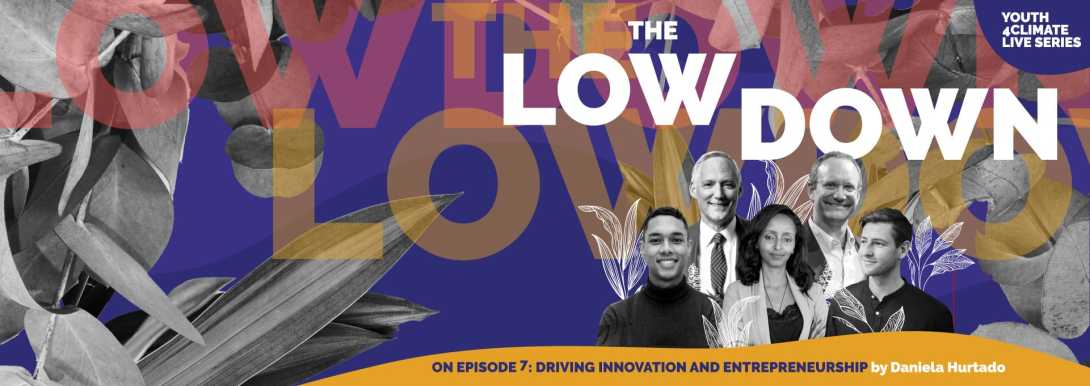
The seventh session of the #YouthForClimateLive Series, which aired on December 11, 2020, made clear that the best way to tackle climate chang

The seventh session of the #YouthForClimateLive Series, which aired on December 11, 2020, made clear that the best way to tackle climate chang
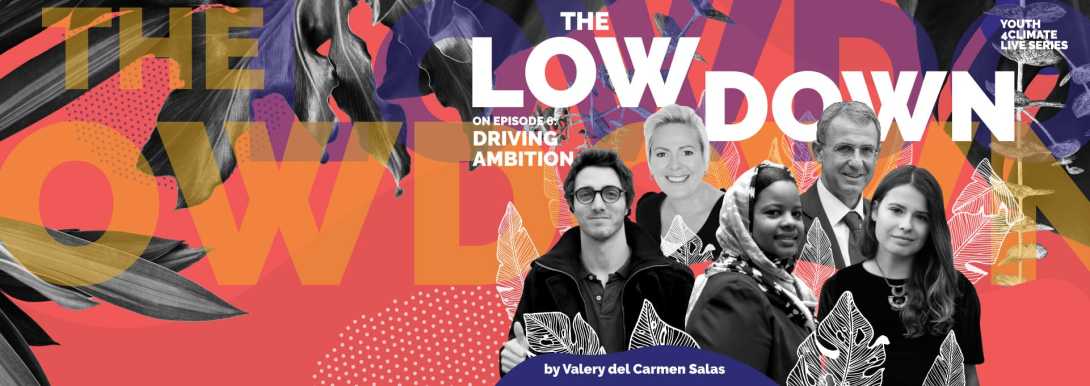
This session of our monthly #Youth4ClimateLive Series was extraordinary.

With the end of 2020 fast approaching and COP26 only a year away, it’s becoming ever more important to ramp up climate ambition and amplify the voices of worldwide #Youth4Climate champions demandin
The #Youth4ClimateLive Educational Toolkit is an interactive document that complements the ongoing #Youth4ClimateLive Series with links to valuable learning resources and impactful #ClimateAction activities. This toolkit was constructed to be widely accessible: educators, students and parents are all welcome.

This article is one of several on the #Youth4ClimateLive Educational Toolkit and will be updated as new episodes of the Youth4Climate Live Series are released.
After watching a great episode of #Youth4ClimateLive, do you get the urge to hop on social media and spread positive climate ambition vibes? Maybe you get those urges all the time! Whatever the occasion, we’ve got just the ticket: fun and easy-to-use #Connect4Climate Action Templates.
These versatile templates are conducive to use in both personal Instagram Stories and in-person or virtual classroom settings. Download the PNG version to use directly on your Instagram, or use the handy printable PDF for an afternoon art project! If you’re meeting virtually, you can use a visual collaboration tool such as Jamboards to create a virtual collage. Take a look below for starter ideas on how to use these templates to spread your climate ambition. You can download your action templates here—we can’t wait to see all of the amazing work that you do!
How to use on Instagram:
Download the PNG file and save it to your mobile device
Create an IG Story and upload the template
Fill in the blanks using the text function. Be creative and use multiple colours, GIFs and emojis
Tag @Connect4Climate with the hashtag #Youth4ClimateLive and share with your friends!
How to use in the in-person classroom:
Download the PDF file and save it to your computer
Print and distribute to students
Fill in the blanks
Post and enjoy!
How to use in the virtual classroom:
Download the PNG file or download the PDF file and save it to your computer
Have students either: follow the steps for Instagram Stories and take a screenshot of their work, or print the PDF, complete and take a photo.
Have students upload their work to a visual collaboration tool such as:
Banner image courtesy of Anastasia Gepp, Pixabay.

This is a dedicated article on the topic of Innovation and Entrepreneurship. Adjoining resources emphasize innovation and entrepreneurship as drivers of adaptation and resilience. This article is a part of the #Youth4ClimateLive Educational Toolkit.
Tackling the climate crisis and creating a sustainable future depend on groundbreaking innovation across all sectors: clean energy, financial tools, business models, policy ideas, low-carbon technologies, and more. Together, we can accelerate the transition to a green economy in a way that leaves no one behind.
The climate challenge presents the next generation with an incredible opportunity to focus their knowledge on innovation and becoming ‘green’ entrepreneurs. Many are already doing just that and finding the response to presenting new approaches for these problems that are both open minded and fully supportive. The thirst for creative ideas is never quenched and there are multiple chances to share original concepts and innovations with a variety of competitions, hackathons, forums and pitch hubs all over the world.
Urging institutions, corporations and entrepreneurs to lead the change with new climate-positive business models is a job for everyone. Young people are particularly positioned to accelerate this transition as they are more open to out-of-the-box thinking and will reap the benefits of a green economy for years to come. Whether it’s through founding their own start-ups, demanding sustainable products from their favorite brands, inventing new technologies, or calling on their leaders to implement policies that incentivise carbon neutral business models, young people have an important role to play.
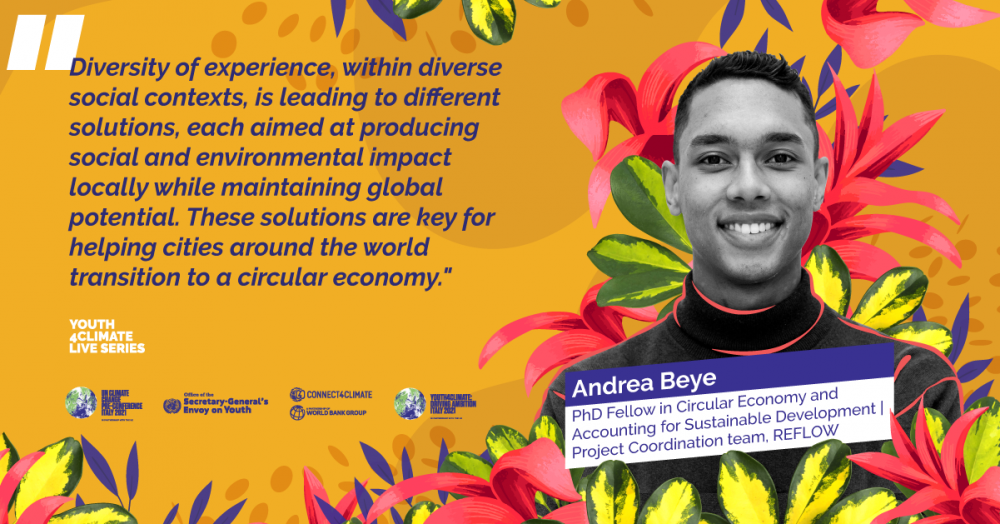
Innovation powers economic competitiveness, creates jobs, and helps ensure that technology and manufacturing enterprises continue to contribute social and economic value to the global economy. To learn more about transformative and innovative action on climate change, you can plan to get involved in the 2021 Innovate4Climate summit, or get inspired by last year’s conference in Singapore here. Innovate4Climate, hosted by the World Bank Group, brings together business, finance, policy and technology leaders to accelerate action on financing climate-smart development.
Rapid application of new low impact technology together with support for education and training is crucial for vulnerable regions and communities around the world to enable them to take advantage of the latest innovations and advance sustainable development. It’s important that the next generation will have the skills needed to make maximum use of a low-carbon economy. Take a look around your own region - how are people in your community thinking outside the box when it comes to tackling climate change? Tell us about green innovation and entrepreneurship that you discover in your own area on Twitter and Instagram. If you’re interested in learning more about the different ways that people around the world are innovating for climate action, check out some of the resources below.
Banner image courtesy of StartupStockPhotos, Pixabay.

Podcasts provide listeners from all over the world with content that is educational, entertaining, and easily accessible at any time and place. As it’s still a relatively new medium (although borrowing from the long traditions of radio), podcasters are continuing to play with style, format, and genre depending on the topic they’re exploring. With the urgency of the climate crisis weighing on the shoulders of global youth, it’s no wonder that many podcasters are harnessing the power of audio storytelling to help people understand what climate change is and what we can do about it.
Offering diverse perspectives and homing in on diverse facets of the #ClimateCrisis, here are some freely accessible podcasts to broaden your climate knowledge base on the go!
Get Your Feet Wet
How to Save a Planet: a podcast hosted by journalist Alex Blumberg and scientist / policy nerd Dr. Ayana Elizabeth Johnson that asks the big questions: what do we need to do to solve the climate crisis and how do we get it done?
Outrage and Optimism: a weekly podcast hosted by #Youth4ClimateLive alum Christiana Figueres that bridges both the outrage we see on the streets as well as the deep conviction that we CAN address climate change
Costing the Earth: BBC podcast bringing you fresh ideas from the sharpest minds working toward a cleaner, greener planet
Forest 404: a narrative podcast in the style of an eco-thriller starring Pearl Mackie
The Biggest Story in the World: this is an older podcast (from 2015) but still gives listeners a strong introduction to the basics of climate change and what solutions we need by going behind the scenes of the Guardian’s mission to tell a compelling and effective climate story
YALE Climate Connections: this is a series of bite-sized audio stories on different climate topics hosted by Dr Anthony Leiserowitz of the Yale Program on Climate Change Communication
You’ve Been Warmed: start off this podcast with an episode featuring #Youth4ClimateLive Launch guest Elizabeth Wathuti
Climate Talk: a youth-led and primarily youth-focused podcast for people all over the world to take practical and guided steps towards addressing Climate Change, hosted by #Youth4ClimateLive alum Seyifunmi Adebote
Just Transitions: An Introduction: a podcast from our colleagues at the Climate Investment Funds on how policy and investment can be leveraged to bring about a just transition to a sustainable future
1,5 Grad: a German-language podcast helmed by #Fridays4Future leader Luisa Neubauer in which she dicusses climate action strategies with experts from various sectors
Dive Deeper
Climate Biz: produced by the International Finance Corporation (IFC), this podcast looks at the news, highlights and opportunities in international climate business
MIT Climate Conversations: a weekly podcast from MIT Climate, an online community connecting questions to answers, research to solutions, and knowledge to action
TILClimate: this MIT podcast breaks down the science, technologies, and policies behind climate change, how it’s impacting us, and what we can do about it
Climate Rising: business and policy leaders join Harvard Business School faculty to discuss what businesses are doing, can do, and should do to confront climate change
Climate Change: this podcast from the National Parks Service asks the questions: how is climate change affecting plants and animals? How is climate change affecting national parks?
The Energy Gang: a weekly digest on energy, cleantech and the environment
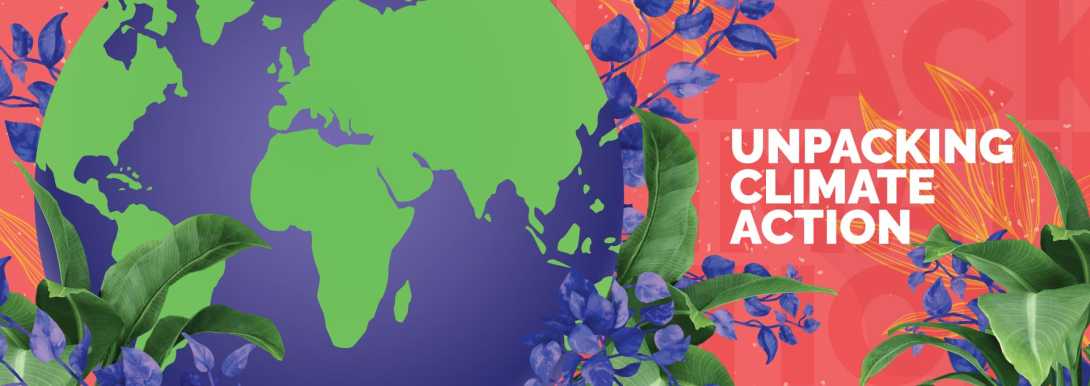
This article provides an overview of the #Youth4ClimateLive Educational Toolkit. Scroll to the bottom for links to the specific constituent parts you're interested in, or download the kit in full here.
Young people all over the world see climate change as the defining crisis of our time and want to take action. This is about their future—both short-term and long-term—and youth voices, ideas, and stories need to be included at the highest levels of decision-making. Many young people are experiencing climate impacts first-hand and others are learning about climate change in schools and universities, but what can they do about it? That’s where the #Youth4ClimateLive Series and complementary Educational Toolkit come in!
<<DOWNLOAD THE TOOLKIT TODAY>>
The #Youth4ClimateLive Series, which concluded in February 2021, brought together a diverse group of unstoppable youth at the forefront of creative climate action for virtual intergenerational and interactive conversations with policymakers and experts on a variety of climate topics. The goal of #Youth4ClimateLive was to engage, educate, and excite a worldwide cohort of young people, empowering them to collaborate with their peers, lead their communities, and influence policymakers to enact meaningful climate action at the local and global levels. The Series offered your people a unique chance to:
Find an accessible and exciting entry-point to exploring the world of climate impacts, solutions and policies through inspirational youth-led conversations.
Learn from the leaders of their generation who are implementing climate solutions within their own communities and be introduced to movers and shakers from the global climate policy landscape.
Connect with other young climate advocates from around the world
Increase their climate literacy on key topics such as: Sustainable Recovery from the COVID-19 crisis, Nature-Based Solutions, and Adaptation & Resilience.
Students that tuned in to the Series also had the opportunity to enter the #SumItUp Competition for a chance to win a spot at the September 2021 Youth4Climate: Driving Ambition event just before Pre-COP26 in Milan. Submissions to the contest closed at the end of March; the winner will be chosen from a pool of finalists by popular vote in the months ahead.
<<SUBSCRIBE TO OUR EDUCATIONAL NEWSLETTER>>
To explain what a Pre-COP is, we should first introduce what a COP is! Every year, the United Nations hosts a high-level climate summit called the Conference of the Parties (COP), where representatives from 197 countries (aka “parties”) convene to take decisions necessary to promote the effective implementation of the UN Framework Convention on Climate Change (UNFCCC). The main aim of the Convention is to prevent “dangerous” human interference with the climate system. Each COP is hosted by a different country, with the first summit being held in Berlin in 1995. You may have heard of the landmark Paris Agreement, which was adopted in 2015 under the French COP21 Presidency. The most recent COP was the 25th, held in Madrid at the end of 2019, where a partnership between the UK and Italy for the presidency of COP26 was decided in response to the UN's call for even more ambitious targets in efforts to implement the Paris Agreement.
The UK will host COP26 in Glasgow from 1 to 12 November 2021, with Italy hosting a number of key preparatory events in Milan such as the youth event "Youth4Climate: Driving Ambition", from 28 to 30 September 2021, and the Pre-COP Summit, from 30 September to 2 October 2021. Pre-COP26 will be attended by around 40 countries, representatives of the UNFCCC Secretariat, the chairs of the Subsidiary Bodies of the Convention and a number of stakeholders who play a key role in the fight against climate change.
The Youth4Climate: Driving Ambition event plans to bring together almost 400 young people aged between 18 and 29 from all over the world for a landmark youth conference in Milan. The first two days will be dedicated to working groups, where the young delegates will have the chance to develop concrete proposals on topics relevant to the COP negotiations, while the final day will host intergenerational discussions between Youth4Climate participants and the Ministers attending Pre-COP26.
If you’re a young person reading this wondering how you can participate, consider getting involved with YOUNGO, the official Youth Constituency of the UNFCCC, and its upcoming Conference of Youth, COY16. You can use the resources in the #Youth4ClimateLive Educational Toolkit to make a difference too. By learning the basics of climate policy and engaging with the #Youth4ClimateLive community, you can share your knowledge and passion with your friends, teachers and community! We all have a role to play, and yours is unique to who you are and the skills, talents, and passions you possess.
What is the #Youth4ClimateLive Educational Toolkit?
The #Youth4ClimateLive Educational Toolkit is an interactive document that links to learning resources and activities to complement the virtual series. This toolkit is constructed in a flexible way so that anyone—educators, students, and/or parents—can use its resources in conjunction with the archived #Youth4ClimateLive episodes to plan exciting lessons & creative activities, dig deeper into important climate topics and engage directly with the global climate community.
The Toolkit is divided into three sections: LEARN, ACT, and GET INSPIRED. Click on the topic in each section to find a web-based interactive collection of resources. In LEARN, resources are labeled to indicate an intermediary or advanced level. “Get Your Feet Wet” resources are accessible to most learning levels while “Dive Deeper” resources are more technical and scholarly, linking to detailed studies and papers. To go beyond learning about the topics, ACT offers an array of activities that can be completed alone or in collaboration with others as classroom exercises - in both virtual and in-person settings. Finally, GET INSPIRED recommends creative ways to engage with climate action through poetry, music, films, games, puzzles, and apps. Everyone has a part to play in creating a resilient and sustainable future and we hope that this toolkit will provide students and youth with new ways of harnessing their creativity, interests, and skills to engage more meaningfully with climate action.
You can also navigate directly to our web-based Toolkit resources using the links below:
Adaptation & Resilience: Collective Efforts for a Sustainable Future
Sustainable Recovery: Building a Better Future Together
Nature-Based Solutions: Working in Harmony With Our Planet
Innovation and Entrepreneurship: Harnessing Creative Climate Solutions
Youth-Led Climate Action: The Rise of a Global Movement
Inclusive Engagement: Amplifying Marginalized Voices
Thumbnail image courtesy of Sasin Tipchai, Pixabay.

This is a dedicated article for suggestions on how to take your climate action further. This article is a part of the #Youth4ClimateLive Educational Toolkit and will be updated throughout the series as new episodes roll out.
The #Youth4ClimateLive Series brings together a diverse group of unstoppable youth at the forefront of creative climate action for virtual monthly discussions in the lead-up to next year’s Pre-COP and COP26 activities (for more on the Series or to find out what a Pre-COP is, please visit our Educational Toolkit Introduction Article). The complementary #Youth4ClimateLive Educational Toolkit aims to help students dig deeper into important climate topics covered in the Series and encourages them to learn more about Climate Ambition and taking #ClimateAction!
We are at a pivotal moment in time where the need for ambitious climate action is just as urgent as it’s ever been and yet major climate events have been postponed while people stay safe at home due to the COVID-19 pandemic. Youth around the world are continuing to mobilize using innovative virtual ways of connecting and organizing. By tuning in to the #Youth4ClimateLive Series every month, young people can stay up to date, broaden their horizons, and connect with the global Youth4Climate community to help drive momentum towards the landmark climate summits now scheduled for the end of 2021.
The #Youth4ClimateLive Educational Toolkit offers additional ideas on how stay engaged through watching inspiring videos and films, learning more about favorite climate solutions, keeping the mind active with games and puzzles, creating poetry and music, and diving into other #ClimateAction activities. We’re hoping that the #Youth4ClimateLive Series and Educational Toolkit will help activate and energize students and young people so that they’re excited to go beyond the parameters of these resources and keep the conversation going in their own communities as they #TakeAction from home.
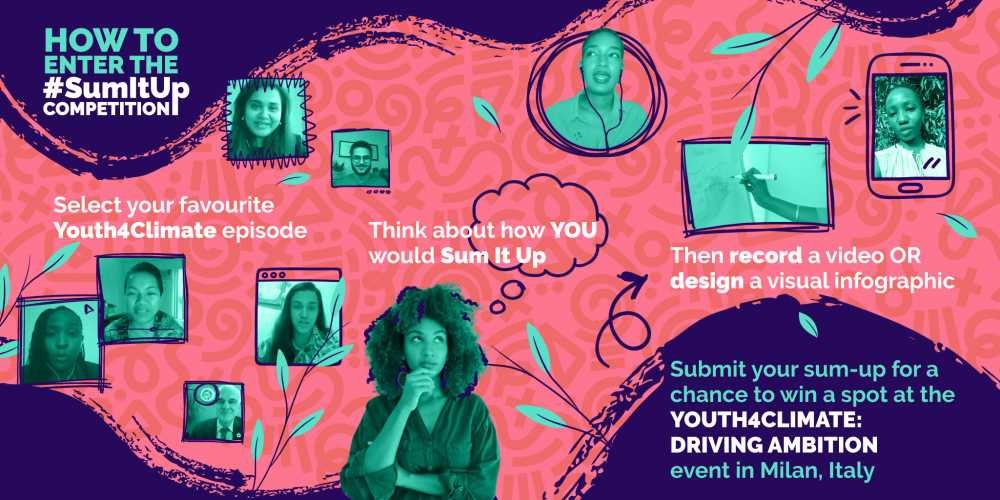
The world needs to continue ratcheting up our collective climate ambition and now is the time to get involved. It’s important to take this time while “business as usual” has been put on hold to prepare for Pre-COP and COP26 so that young people can be a driving force for ambitious action and a successful outcome. Any young person looking to participate directly in the Youth4Climate: Driving Ambition event in Milan next year should submit to the #SumItUp competition and follow @Connect4Climate on social media to get the latest news on what’s being planned. Looking for additional ways to get involved? See what resonates with you below and find your place in the movement!
Banner image courtesy of Milada Vigerova, Pixabay.
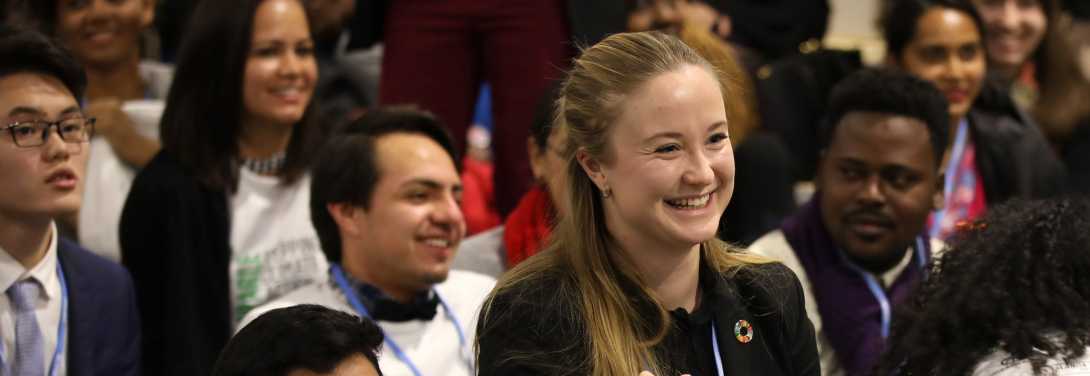
This is a dedicated article on the topic of Youth-Led Climate Action. This article is a part of the #Youth4ClimateLive Educational Toolkit.
For years, young people have been crucial in focusing global attention on the urgent need to act on climate. Global youth climate movements have been a wake-up call for leaders, proving that young people can no longer be dismissed when it comes to paving the way forward. The way we engage young people today will determine the prospects for sustainable development and peace. Young people, who represent a majority of the population in most developing countries, are today visibly contributing as political actors, innovators, entrepreneurs and peace-builders. At the same time, youth face disproportionate social, economic and political barriers, which prevent them from unleashing their full potential. Utilizing young people’s potential as agents of change requires involving and empowering them in the development of policy and supporting their participation at all levels.
Throughout the #Youth4ClimateLive series, we heard from inspiring youth leaders who are calling for ambitious action from their leaders and implementing climate solutions on the ground in their communities. In Episode 3: Driving Youth Action, we dived into how decision makers can meaningfully engage with young people in developing climate policies and implementing sustainable solutions. Some of the Episode’s guests serve as advisors through official channels in multilateral institutions, such as the UN Secretary-General’s Youth Advisory Group on Climate Change and YOUNGO. While space has been made to include these important youth voices within high-level processes, many of these leaders got their start by driving action in their own communities at the grassroots level.
From Severn Suzuki’s famous speech at the 1992 Rio Earth Summit to Greta Thunberg’s powerful words at the UN Climate Action Summit in 2019, youth have been calling on leaders to take urgent and ambitious climate action for many years. Young filmmaker Slater Jewell-Kemker documented this rise of the global youth climate movement in her film Youth Unstoppable, which offers a personal and first-hand look at the stories of youth on the front lines of climate change refusing to let their futures slip away.
Beyond being a consistent voice for action, young people are also an integral part of the international climate policy discussion. In 2009, the UNFCCC recognized youth groups as an official constituency called “YOUNGO” (Youth + NGO) and after two years operating under a provisional status, YOUNGO became fully recognized at COP17 in Durban, South Africa. YOUNGO has since served as both the official conduit for youth participation in the UN climate talks and as a global network of youth and youth-focused organizations working on climate change. Currently, YOUNGO has a member base of 200 youth-non-governmental organisations and 5500+ individuals from across the globe.
If you’re a young person reading this and wondering how you can become a youth climate champion, there are lots of ways to get involved! Use the resources below to learn more about the global youth climate movement at both the local and global levels, then take a look at the ACT section of the #Youth4ClimateLive Educational Toolkit to explore ways you can get involved.
Hosted by the World Bank Group and supported by Italy’s Ministry of the Environment and Energy Security and Germany’s Federal Ministry for Economic Cooperation and Development, Connect4Climate (C4C) is a global partnership for a livable planet that connects, creates, and communicates to build long-lasting change for future generations.